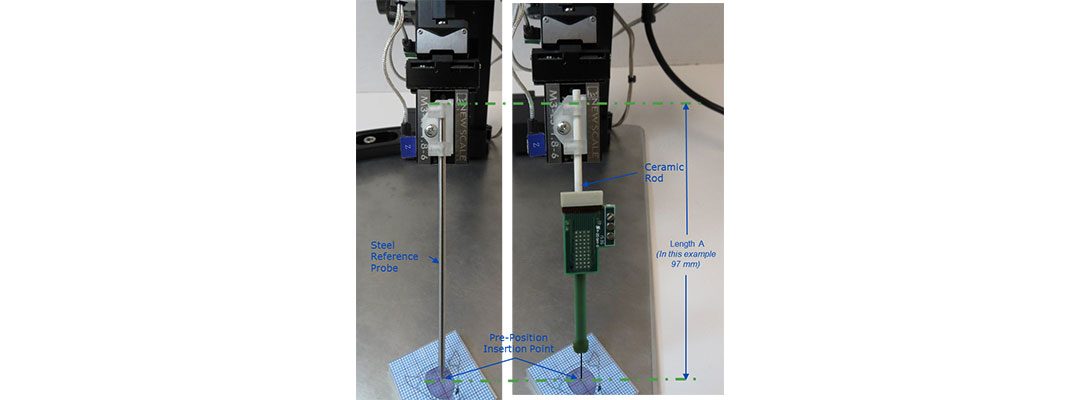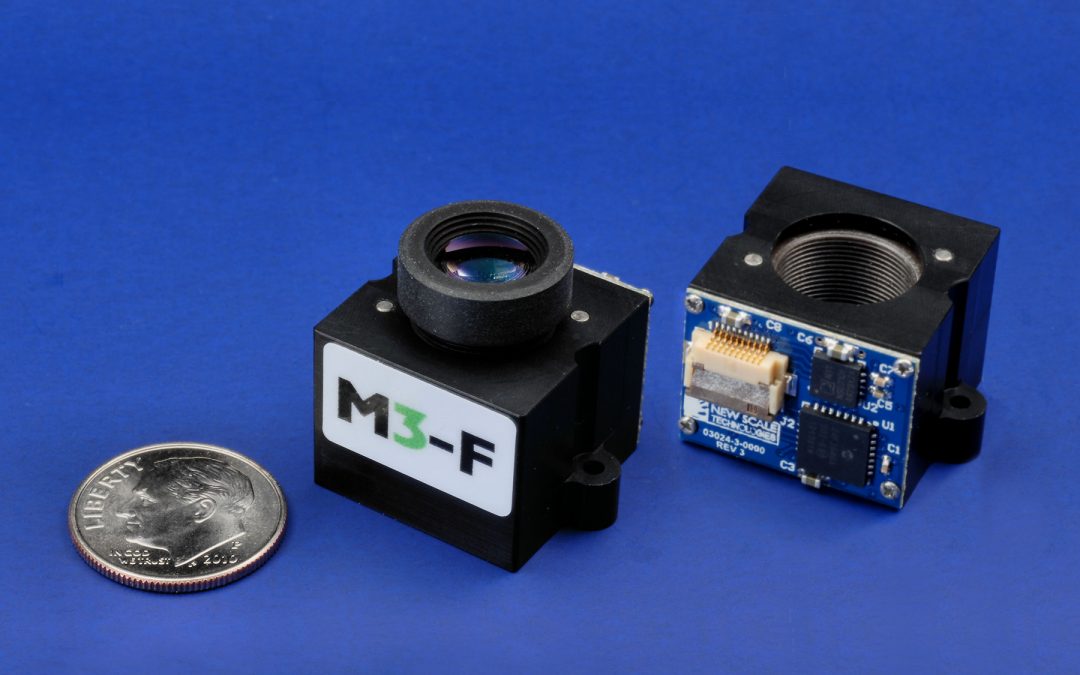Tips and techniques for applying M3 micro-mechatronic modules and SQUIGGLE micro motors in miniature product applications.
New Scale’s engineering team supports our OEM customers with design and integration assistance, custom motion system development, and customized micro motors and modules. We can help you design rails, mounting assemblies, drivers, position sensors, limit switches, and other micro-mechatronic elements to deliver optimal performance in your system. Contact us today.
Jun 25, 2024 | Application Notes
Prior to purchasing the M3-FS or M3-F Focus Module Developer’s Kit, you should verify compatibility of configuration to your lens and imager format. This design note outlines how to validate system compatibility.

May 27, 2022 | Application Notes, Blogs, Neuroscience Blog
By clamping as far back from the probe shank as possible, the MPM Probe Mount 1As allows researchers to maximize the density of probes in multi-probe neural recording experiments. Mount Maximizes Density of Neuropixels 1.0 Probes in Multi-Probe Recording New Scale’s...

Jan 13, 2022 | Application Notes, Blogs, Micro Motion Blog, Top News
To achieve the goals of higher throughput and lower costs, NGS instrument developers are using smaller samples, parallel sequencing, and more automation. These factors necessitate miniaturization and distributed control of the photonics subsystems used in DNA sequencing instruments.

Dec 10, 2021 | Application Notes, Neuroscience Blog, Top News
How to use the alignment fixture The alignment fixture simplifies mounting of Neuropixels probes onto the MPM Multi-Probe Micromanipulator and other manipulators*. This recording of the live demo shows the use of the Alignment Fixture with two different probe mounts: ...

Apr 3, 2017 | Application Notes
M3 micro-mechatronics modules are “all in-one” smart modules, with the controller and position sensor built in to the miniature module. This embedded closed-loop control gives you the smallest size, fastest and simplest integration into your system, and lowest total cost. When the application requires, M3 Smart Modules can also move using open-loop commands from the SPI, I2C or UART interface. This is particularly useful in applications that have an external sensor with better resolution than the internal sensor, or where very fast “step and settle” performance is required.

Jun 8, 2016 | Application Notes
New Scale worked with NASA JPL/Caltech to design and manufacture a fiber optic positioning system using rotary piezoelectric SQUIGGLE micro motors for the Prime Focus Spectrograph (PFS). The PFS is a fiber fed multi-object spectrometer for the Subaru Telescope that will conduct a variety of targeted surveys for studies of dark energy, galaxy evolution, and galactic archaeology. The key to the instrument is a high density array of fiber positioners placed at the prime focus of the Subaru Telescope. The system, nicknamed the “Cobra” fiber positioner, will be capable of rapidly reconfiguring the array of 2,394 optical fibers to the image positions of astronomical targets in the focal plane with high accuracy.
Mar 3, 2016 | Application Notes
M3 micro-mechatronics modules are “all in-one” smart modules, with the controller and position sensor built in to the miniature module. This embedded closed-loop control gives you the smallest size, fastest and simplest integration into your system, and lowest total cost.
When the application requires, M3 Smart Modules can also move using open-loop commands from the SPI, I2C or UART interface. This is particularly useful in applications that have an external sensor with better resolution than the internal sensor, or where very fast “step and settle” performance is required.

Nov 8, 2015 | Application Notes
Field-deployable and mobile tuning systems require smaller actuators that use very low power, yet offer high precision and accuracy as well as long travel. For RF transmission systems, the demand for smaller size comes from the need to pack more capability into smaller boxes – whether to satisfy consumer preference for compact in-home devices, or the need for higher densities in outdoor instruments.
New Scale provides compact, high-precision motion solutions for this market. Based on our patented piezoelectric motor and related technology, our miniature closed-loop motion modules provide unmatched position resolution and accuracy. Unlike traditional motors, the modules do not generate magnetic fields while moving. Their compact size and low power use make them ideal for inductive or capacitive tuning in field-deployable and portable systems.
Aug 21, 2015 | Application Notes
New Scale’s miniature M3 beam steering modules are designed for precise point-to-point positioning and dynamic movements up to 1K Hz. The direct-drive piezoelectric motors inside the modules hold position with zero power and no servo jitter. The effects of external vibrations on the mirror position are highly damped. M3 smart modules have fully-integrated closed loop controllers and communicate directly with your system processor over a standard serial interface. They have low drive voltage and low power use, making them ideal for portable instruments. This tech bulletin describes three types of beam steering solutions: a two-mirror system with galvo-type motion, a single-mirror solution with a tilting around a central pivot, and a dual-wedge Risley device.
SEE ALSO: our standard M3-RS rotary stages for beam steering using a familiar galvano-scanner style form factor.

Aug 12, 2014 | Application Notes
New Scale M3-F S and M3-F focus modules mount directly to a printed circuit board over a CCD or CMOS image sensor. These tiny modules add precision focus to OEM cameras while preserving their compact size advantage. They accept high-level motion commands directly from your ISP – no additional control board is needed.
The module accepts standard threaded lens assemblies and is only slightly larger than the lens assembly. It provides millimeters of lens motion with 0.5 μm resolution. The new M3-FS has the added benefits of high dynamic stability, minimizing pixel shift when the camera is moving and changing orientation.
The M3-F is a single-lens system with embedded closed-loop drive for high repeatability with low external processing requirements.

Nov 29, 2011 | Application Notes, Micro Motion Blog
We all are familiar with the consumer digital cameras that are in our pockets, mobile phones and personal computers. Thanks to incredible advances in microelectronics, CMOS image sensors and optics, most of us have a very good camera within reach most of the time.
Now these tiny cameras are inspiring product engineers in “non-consumer” applications—such as biometric identification, medical and diagnostic devices, and machine vision—to make even greater products. In fact, markets for these new applications are projected to grow faster than consumer camera markets over the next few years.
In this article we discuss sensor and lens requirements, compare the M3-F focus module to voice coil motors and stepper motors, and talk about image processing, digital signal processing and other system considerations.

Jun 1, 2010 | Application Notes
New Scale’s custom UTAF™ (Ultra-Thin Autofocus) modules combine a motor with a linear guide mechanism to create an ultra-thin autofocus lens module. It is based on our patented UTAF piezoelectric motor, in which an ultrasonically vibrating beam is oriented...









